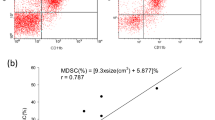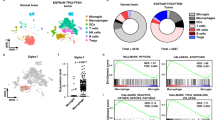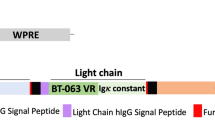Abstract
Human U251MG glioma cells retrovirally transduced with the human gene for the membrane form of macrophage colony-stimulating factor (mM-CSF) were investigated. The clones, MG-2F11 and MG-2C4, that expressed the most mM-CSF, but not the viral vector or the parental U251MG cells, were killed by both murine and human monocyte/macrophages in cytotoxicity assays. MG-2F11 cells failed to form subcutaneous tumors in either nude or NIH-bg-nu-xidBR mice, while mice inoculated with the U251MG viral vector (MG-VV) cells developed tumors. Electron microscopy studies showed that 4 hours after subcutaneous injection, the mM-CSF-transduced cells began dying of a process that resembled paraptosis. The dying tumor cells were swollen and had extensive vacuolization of their mitochondria and endoplasm reticulum. This killing process was complete within 24 hours. Macrophage-like cells were immediately adjacent to the killed MG-2F11 cells. Immunohistological staining for the heat shock proteins HSP60, HSP70 and GRP94 (gp96) showed that 18 hours after inoculation into nude mice, the MG-2F11 injection site was two to four times more intensely stained than the MG-VV cells. This study shows that human gliomas transduced with mM-CSF have the potential to be used as a safe live tumor cell vaccine.
This is a preview of subscription content, access via your institution
Access options
Subscribe to this journal
Receive 12 print issues and online access
$259.00 per year
only $21.58 per issue
Buy this article
- Purchase on Springer Link
- Instant access to full article PDF
Prices may be subject to local taxes which are calculated during checkout






Similar content being viewed by others
References
Jemel A, Thomas A, Murray A, Thun M . Cancer statistics 2002. CA Cancer J Clin. 2002;52:23–45.
Huncharek M, Muscat J . Treatment of recurrent high grade astrocytoma; results of a systematic review of 1,415 patients. Anticancer Res. 1998;18:1303–1311.
Jubelirer SJ . A review of the treatment and survival rates of 138 patients with glioblastoma multiforme. WV Med J. 1996;92:186–190.
Parney IF, Farr-Jones MA, Chang LJ, Petruk KC . Human glioma immunobiology in vitro: implications for immunogene therapy. Neurosurgery. 2000;46:1169–1177.
Ewend MG, Thompson RC, Anderson R, et al. Intracranial paracrine interleukin-2 therapy stimulates prolonged antitumor immunity that extends outside the central nervous system. J Immunother. 2000;23:438–448.
Plautz GE, Miller DW, Barnet GH, et al. T Cell adoptive immunotherapy of newly diagnosed gliomas. Clin Cancer Res. 2000;6:2209–2218.
Hayes RL . The cellular immunotherapy of primary brain tumors. Rev Neurol (Paris). 1992;148:454–466.
Quattrocchi KB, Miller CH, Cush S, et al. Pilot study of local autologous tumor infiltrating lymphocytes for the treatment of recurrent malignant gliomas. J Neuro-Oncol. 1999;45:141–157.
Kruse CA, Cepeda L, Owens B, et al. Treatment of recurrent glioma with intracavity alloreactive cytotoxic T lymphocytes and interleukin-2. Cancer Immunol Immunother. 1997;45:77–87.
Parney IF, Hao C, Petruk KC . Glioma immunology and immunotherapy. Neurosurgery. 2000;46:778–791.
Giezeman-Smits KM, Okada H, Brissette-Storkus CS, et al. Cytokine gene therapy of gliomas: induction of reactive CD4+T cells by interleukin-4-transfected 9L gliosarcoma is essential for protective immunity. Cancer Res. 2000;60:2449–2457.
Fathallah-Shaykh HM, Gao W, Cho M, Herrera MA . Priming in the brain, an immunologically privileged organ, elicits anti-tumor immunity. Int J Cancer. 1998;75:266–276.
Herrlinger U, Kramm CM, Johnston KM, et al. Vaccination for experimental gliomas using GM-CSF-transduced glioma cells. Cancer Gene Ther. 1997;4:345–352.
Graf MR, Prins RM, Merchant RE . IL-6 secretion by a rat T9 glioma clone induces a neutrophil-dependent antitumor response with resultant cellular, antiglioma immunity. J Immunol. 2000;166:121–129.
Tjuvajev J, Gansbacher B, Desai R, et al. RG-2 glioma growth attenuation and severe brain edema caused by local production of interleukin 2 and interferon-γ. Cancer Res. 1995;55:1902–1910.
Visse E, Siesjo P, Widegren B, and Sjogren O., Regression of intracerebral rat glioma isografts by therapeutic subcutaneous immunization with interferon-γ, interleukin-7, or B7-1-transfected tumor cells. Cancer Gene Ther. 1999;6:37–44.
Okada H, Giezeman-Smits KM, Tahara H, et al. Effective cytokine gene therapy against an intracranial glioma using a retrovirally transduced IL-4 plus HSVtk tumor vaccine. Gene Ther. 1996;6:219–226.
Herrlinger U, Kramm CM, Johnston KM, et al. Vaccination for experimental gliomas using GM-CSF transduced glioma cells. Cancer Gene Ther. 1997;4:345–352.
Parney IF, Petruk KC, Zhang C, et al. Granulocyte–macrophage colony stimulating factor and B7-2 combination immunogene therapy in an allogeneic Hu-PBL-SCID/Beige mouse-human glioblastoma multiforme model. Human Gene Ther. 1997;8:1073–1085.
Jadus MR, Irwin MCN, Irwin MR, et al. Macrophages can recognize and kill tumor cells bearing the membrane isoform of macrophage colony stimulating factor. Blood 1996;87:5232–5241.
Jadus MR, Williams CC, Avina MD, et al. Macrophages kill T9 glioma tumor cells bearing the membrane isoform of macrophage colony stimulating factor through a phagocytosis-dependent pathway. J Immunol. 1998;160:361–368.
Graf MR, Jadus MR, Wepsic HT, et al. Development of systemic immunity to glioblastoma multiforme using tumor cells genetically engineered to express the membrane bound isoform of macrophage colony stimulating factor (CSF-1). J Immunol. 1999;163:5544–5551.
Jadus MR, Wepsic HT, Jeffes EWB . The biology and potential anti-cancer uses of the membrane form of macrophage colony stimulating factor. Recent Res Dev Immunol. 1999;1:267–281.
Sanchez R, Williams CC, Daza JL, et al. T9 glioma cells expressing membrane macrophage colony stimulating factor produce CD4+t cell-associated protective immunity against T9 intracranial gliomas and systemic immunity against different syngeneic gliomas. Cell Immunol. 2002;216:1–11.
Williams CC, Trinh H, Tran TV, et al. Membrane expression of macrophage colony stimulating factor on MADB106 breast cancer cells is not associated with in vitro cytotoxicity by macrophages but is associated with the induction lasting tumor immunity against syngeneic breast cancer cells in vivo. Mol Ther. 2001;3:216–221.
Dan Q, Sanchez R, Delgado C, et al. Non-immunogenic murine hepatocellular carcinoma Hepal-6 cells expressing the membrane form of macrophage colony stimulating factor are rejected in vivo and lead to CD8 T cell immunity against the parental tumor. Mol Ther. 2001;4:427–437.
Charley MR, Mikhael A, Hackett J, et al. Mechanism of anti-asialo GM1 prevention of graft versus host disease identification of allo-antigen activation of T cells. J Invest Derm. 1988;91:202–206.
Enzan H, Hiroi M, Saibara T, et al. Immunoelectron microscopic identification of asialo GM1-positive cells in adult rat liver. Virchows Arch B Cell Pathol. 1991;60:389–398.
Sperandio S, de Belle I, Bredesen DE . An alternative, non-apoptotic form of programmed cell death. Proc Natl Acad Sci (USA). 2000;97:14376–14381.
Basu S, Binder RJ, Suto R, et al. Necrotic but not apoptotic cell death releases heat shock proteins, which deliver a partial maturation signal to dendritic cells and activate NF-κB pathway. Internatl Immunol. 2000;12:1539–1546.
Chen Y, Douglass T, Jeffes EWB, et al. Living T9 glioma cancer cells expressing membrane macrophage colony stimulating factor produce immediate tumor destruction by polymorphonuclear leukocytes, and macrophages via a “paraptosis”-induced pathway that promotes systemic immunity against intracranial T9 gliomas. Blood 2002; 100:1373–1380.
Fadok VA, Bratton DL, Konowaal A, et al. Macrophages that have ingested apoptotic cells in vitro inhibit proinflammatory cytokine production through autocrine/paracrine mechanisms involving TGF-ß, PGE2 and PAF. J Clin Invest. 1998;101:890–898.
Barker RN, Erwig L, Pearce WP, et al. Differential effects of necrotic or apoptotic cell uptake on antigen presentation by macrophages. Pathobiology. 1999;67:302–305.
Voll RE, Herrmann M, Roth EA, et al. Immunosuppressive effects of apoptotic cells. Nature 1997;390:350–351.
Gallucci S, Lolkema M, Matzinger P . Natural adjuvants: endogenous activators of dendritic cells. Nat Med. 1999;5:1249–1255.
Melcher A, Todryk S, Hardwick N, et al. Tumor immunogenicity is determined by the mechanism of cell death via induction of heat shock protein expression. Nat Med. 1998;4:581–587.
Sauter B, Albert ML, Francisco L, et al. Consequences of cell death: exposure to necrotic tumor cells, but not primary tissue cells or apoptotic cells, induces the maturation of immunostimulatory dendritic cells. J Exp Med. 2000;191:423–433.
Galluci S Matzinger P . Danger signals: SOS to the immune system. Curr Opin Immunol. 2001;13:114–119.
Srivastava P . Interaction of heat shock proteins with peptides and antigen presenting cells: chaperoning of the innate and adaptive immune responses. Annu Rev Immunol. 2002;20:395–425.
Suto R, Srivastava PK . A mechanism for the specific immunogenicity of heat shock protein-chaperoned peptides. Science 1995;269:1585–1588.
Binder RJ, Blachere NE, Srivastava PK . Heat shock protein-chaperoned peptides but not free peptides introduced into the cytosol are presented efficiently by major histocompatibility complex I molecules. J Biol Chem. 2001;276:17163–17171.
Basu S, Binder RJ, Ramalingam T, Srivastava PK . CD91 is a common receptor for heat shock proteins gp96, hsp90, hsp70 and calreticulin. Immunity 2001;14:303–313.
Kuppner MC, Gastpar R, Gelwar S, et al. The role of heat shock protein (hsp 70) in dendritic cell maturation: Hsp70 induces the maturation of immature dendritic cells but reduce DC differentiation from monocyte precursors. Eur J Immunol. 2001;31:1602–1609.
Asea A, Kraeft SK, Kurt-Jones EA, et al. HSP70 stimulates cytokine production through a CD14-dependent pathway, demonstrating its dual role as a chaperone and cytokine. Nat Med. 2000;6:435–442.
Huang P, Allam A, Taghian A, et al. Growth and metastatic behavior of five human glioblastomas compared with nine other histological types of human tumor xenografts in SCID mice. J Neurosurg. 1995;83:308–315.
Westphal M, Hansel M, Brunken M, et al. Initiation of primary cell cultures from human intracranial tumors on extracellular matrix from bovine corneal endothelial cells. Exp Cell Biol. 1987;55:152–163.
Arnold D, Faath S, Rammensee H, Schild H . Cross-priming of minor histocompatibility antigen specific cytotoxic T cells upon immunization with the heat shock protein pg96. J Exp Med. 1995;182:885–889.
Li Z, Menoret A, Srivastava P . Roles of heat-shock proteins in antigen presentation and cross-presentation. Curr Opin Immunol. 2002;14:45–51.
Acknowledgements
This study was funded in part from grants obtained from the Veterans Affairs Medical Center (HTW, MRJ) and the NIH Grant CA77802 R01 (MRJ) and the Avon Breast Cancer Foundation via the University of California at Irvine Cancer Research Program.
Author information
Authors and Affiliations
Corresponding author
Rights and permissions
About this article
Cite this article
Jadus, M., Chen, Y., Boldaji, M. et al. Human U251MG glioma cells expressing the membrane form of macrophage colony-stimulating factor (mM-CSF) are killed by human monocytes in vitro and are rejected within immunodeficient mice via paraptosis that is associated with increased expression of three different heat shock proteins. Cancer Gene Ther 10, 411–420 (2003). https://doi.org/10.1038/sj.cgt.7700583
Received:
Published:
Issue Date:
DOI: https://doi.org/10.1038/sj.cgt.7700583
Keywords
This article is cited by
-
Paraptosis: a non-classical paradigm of cell death for cancer therapy
Acta Pharmacologica Sinica (2024)
-
Inverse correlation between Interleukin-34 and gastric cancer, a potential biomarker for prognosis
Cell & Bioscience (2020)
-
Macrophage colony-stimulating factor and cancer: a review
Tumor Biology (2014)
-
Wilms’ tumor 1 silencing decreases the viability and chemoresistance of glioblastoma cells in vitro: a potential role for IGF-1R de-repression
Journal of Neuro-Oncology (2011)
-
Going up in flames: necrotic cell injury and inflammatory diseases
Cellular and Molecular Life Sciences (2010)



